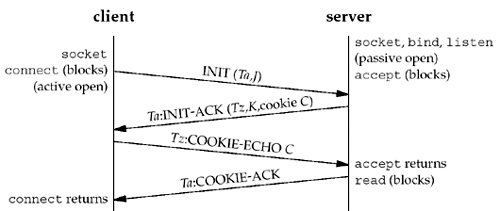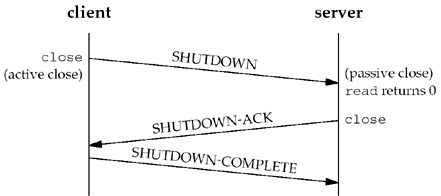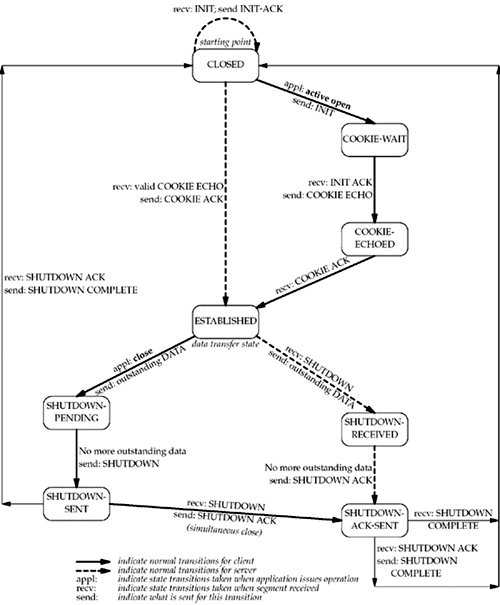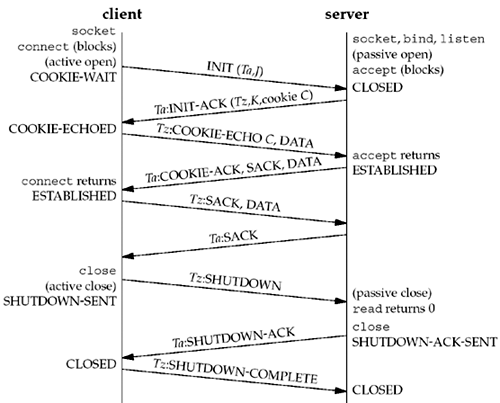2.8 SCTP Association Establishment and
Termination
SCTP is connection-oriented like TCP, so it also
has association establishment and termination handshakes. However,
SCTP's handshakes are different than TCP's, so we describe them
here.
Four-Way Handshake
The following scenario, similar to TCP, occurs
when an SCTP association is established:
-
The server must
be prepared to accept an incoming association. This preparation is
normally done by calling socket, bind, and
listen and is called a passive
open.
-
The
client issues an active open by
calling connect or by sending a message, which implicitly
opens the association. This causes the client SCTP to send an INIT
message (which stands for "initialization") to tell the server the
client's list of IP addresses, initial sequence number, initiation
tag to identify all packets in this association, number of outbound
streams the client is requesting, and number of inbound streams the
client can support.
-
The
server acknowledges the client's INIT message with an INIT-ACK
message, which contains the server's list of IP addresses, initial
sequence number, initiation tag, number of outbound streams the
server is requesting, number of inbound streams the server can
support, and a state cookie. The state cookie contains all of the
state that the server needs to ensure that the association is
valid, and is digitally signed to ensure its validity.
-
The
client echos the server's state cookie with a COOKIE-ECHO message.
This message may also contain user data bundled within the same
packet.
-
The
server acknowledges that the cookie was correct and that the
association was established with a COOKIE-ACK message. This message
may also contain user data bundled within the same packet.
The minimum number of packets required for this
exchange is four; hence, this process is called SCTP's four-way handshake. We show a picture of the
four segments in Figure
2.6.

The SCTP four-way handshake is similar in many
ways to TCP's three-way handshake, except for the cookie
generation, which is an integral part. The INIT carries with it
(along with its many parameters) a verification tag, Ta, and an initial sequence number,
J. The tag Ta must be present in every packet sent by the
peer for the life of the association. The initial sequence number
J is used as the starting sequence
number for DATA messages termed DATA chunks. The peer also chooses
a verification tag, Tz, which must
be present in each of its packets for the life of the association.
Along with the verification tag and initial sequence number,
K, the receiver of the INIT also
sends a cookie, C. The cookie
contains all the state needed to set up the SCTP association, so
that the server's SCTP stack does not need to keep information
about the associating client. Further details on SCTP's association
setup can be found in Chapter 4 of [Stewart and Xie 2001].
At the conclusion of the four-way handshake,
each side chooses a primary destination address. The primary
destination address is used as the default destination to which
data will be sent in the absence of network failure.
The four-way handshake is used in SCTP to avoid
a form of denial-of-service attack we will discuss in Section
4.5.
SCTP's four-way handshake using Cookies
formalizes a method of protection against this attack. Many TCP
implementations use a similar method; the big difference is that in
TCP, the cookie state must be encoded into the initial sequence
number, which is only 32 bits. SCTP provides an arbitrary-length
field, and requires cryptographic security to prevent attacks.
Association Termination
Unlike TCP, SCTP does not permit a "half-closed"
association. When one end shuts down an association, the other end
must stop sending new data. The receiver of the shutdown request
sends the data that was queued, if any, and then completes the
shutdown. We show this exchange in Figure 2.7.

SCTP does not have a TIME_WAIT state like TCP,
due to its use of verification tags. All chunks are tagged with the
tag exchanged in the INIT chunks; a chunk from an old connection
will arrive with an incorrect tag. Therefore, in lieu of keeping an
entire connection in TIME_WAIT, SCTP instead places verification
tag values in TIME_WAIT.
SCTP State Transition Diagram
The operation of SCTP with regard to association
establishment and termination can be specified with a state transition diagram. We show this in
Figure 2.8.

As in Figure 2.4, the
transitions from one state to another in the state machine are
dictated by the rules of SCTP, based on the current state and the
chunk received in that state. For example, if an application
performs an active open in the CLOSED state, SCTP sends an INIT and
the new state is COOKIE-WAIT. If SCTP next receives an INIT ACK, it
sends a COOKIE ECHO and the new state is COOKIE-ECHOED. If SCTP
then receives a COOKIE ACK, it moves to the ESTABLISHED state. This
final state is where most data transfer occurs, although DATA
chunks can be piggybacked on COOKIE ECHO and COOKIE ACK chunks.
The two arrows leading from the ESTABLISHED
state deal with the termination of an association. If an
application calls close before receiving a SHUTDOWN (an
active close), the transition is to the SHUTDOWN-PENDING state.
However, if an application receives a SHUTDOWN while in the
ESTABLISHED state (a passive close), the transition is to the
SHUTDOWN-RECEIVED state.
Watching the Packets
Figure
2.9 shows the actual packet exchange that takes place for a
sample SCTP association: the association establishment, data
transfer, and association termination. We also show the SCTP states
through which each endpoint passes.

In this example, the client piggybacks its first
data chunk on the COOKIE ECHO, and the server replies with data on
the COOKIE ACK. In general, the COOKIE ECHO will often have one or
more DATA chunks bundled with it when the application is using the
one-to-many interface style (we will discuss the one-to-one and
one-to-many interface styles in Section 9.2).
The unit of information within an SCTP packet is
a "chunk." A "chunk" is self-descriptive and contains a chunk type,
chunk flags, and a chunk length. This approach facilitates the
bundling of chunks simply by combining multiple chunks into an SCTP
outbound packet (details on chunk bundling and normal data
transmission procedures can be found in Chapter 5 of [Stewart and
Xie 2001]).
SCTP Options
SCTP uses parameters and chunks to facilitate
optional features. New features are defined by adding either of
these two items, and allowing normal SCTP processing rules to
report unknown parameters and unknown chunks. The upper two bits of
both the parameter space and the chunk space dictate what an SCTP
receiver should do with an unknown parameter or chunk (further
details can be found in Section 3.1 of [Stewart and Xie 2001]).
Currently, two extensions for SCTP are under
development:
-
The dynamic
address extension, which allows cooperating SCTP endpoints to
dynamically add and remove IP addresses from an existing
association.
-
The partial
reliability extension, which allows cooperating SCTP endpoints,
under application direction, to limit the retransmission of data.
When a message becomes too old to send (according to the
application's direction), the message will be skipped and thus no
longer sent to the peer. This means that not all data is assured of
arrival at the other end of the association.
|